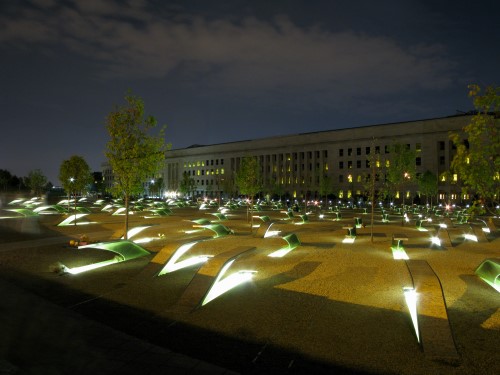Trail of Tributes: September 11 Memorial Trail Honors America’s Fallen Heroes

The 9/11 memorial trail project is a fusion of three themes: pilgrimage and remembrance, nation-building and resilience, and trail connectivity.
On a bright June afternoon, Debby Borza leads a small group of visitors along a footpath overlooking hundreds of acres of green fields in Somerset County, Pennsylvania. She reflects on the once-scarred land of this abandoned strip mine, pointing out the newest changes to the landscape: 40 groves of 40 young maples. The groves were planted in memory of the 40 flight passengers and crew members who lost their lives here on the morning of September 11, 2001.
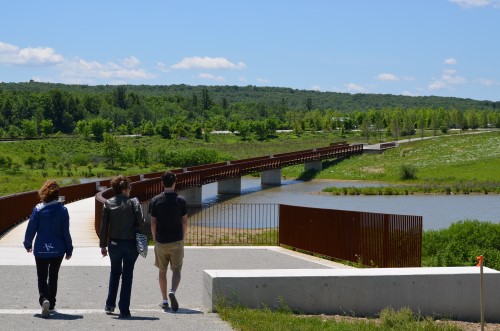
One of those people was Borza’s 20-year-old daughter Deora Bodley, a student on her way to begin her junior year in college. The Pennsylvania strip mine—one of three sites marking the worst terrorist attack in U.S. history—is where Borza and the other family members of the 40 people on Flight 93 came to mourn their loved ones. It’s a place she now returns to several times a year to focus her thoughts and energies on renewal.
This place of grief and hope so personal to Borza and the other Flight 93 family members has also become part of America’s collective national memory. It’s a site that is preserved now by the National Park Service as the Flight 93 National Memorial.
As Borza turns to head back to the visitors’ center, she spots a couple of weary-looking cyclists crossing the parking lot. The two women are coming from the main park entrance—which means they must have ridden Route 30, a dangerous stretch of road for bikes. She introduces herself and asks if they need help or directions.
“Is there trail access to the memorial now?” one of the cyclists asks. “We rode in off the GAP to remember Flight 93, but we weren’t sure if the new trail was open yet.”
Connections Across 1,300 Miles
The brand-new trail connection that Borza pointed out to the riders that day is far more than a day-trip spur off the Great Allegheny Passage (GAP). It’s a critical link in a 1,300-mile triangle of trails connecting the Flight 93 memorial to the Pentagon outside Washington, D.C., and New York City’s Ground Zero.
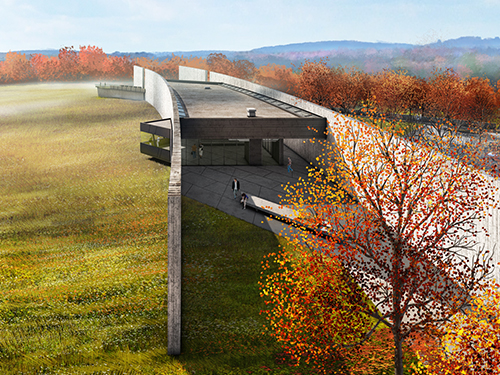
The September 11th National Memorial Trail (NMT) is a multi-use circuit born of many different kinds of connections—among trail advocates, communities, existing trails and even moments in history. Its first leg runs northwest from the Pentagon Memorial, following the Chesapeake & Ohio Canal National Historical Park to the GAP at Cumberland, Maryland. It links to the Flight 93 memorial via a newly acquired rail right-of-way from Garrett, Pennsylvania. The second leg extends east from the Flight 93 memorial to New York City’s National September 11 Memorial, piggybacking along many rail-trails and community trails in Pennsylvania and New Jersey. The third leg, from New York City to the Pentagon Memorial, follows the East Coast Greenway south through five states.
The founders of the NMT, a corps of trails advocates who conceived the idea just days after 9/11, describe the project as a fusion of three distinct themes. First, it is a secular pilgrimage experience, a journey of remembrance of the fallen of 9/11 and of tribute to its first responders. Whether it’s traveled by foot, bike, motorcycle or car, the route offers opportunities to reflect on the events that changed the nation’s course and consciousness. Second, the trail is a tour of landmarks that focuses on themes of American nation-building and resilience. It’s this thematic emphasis that shapes the new east-west trail alignment between Pennsylvania and New Jersey.
Finally, the September 11th National Memorial Trail marks a bold new experiment in trail connectivity. The wiggly lines of the route map bear witness to the hundreds of partners—big and small, public and private—that made the vast triangle complete.
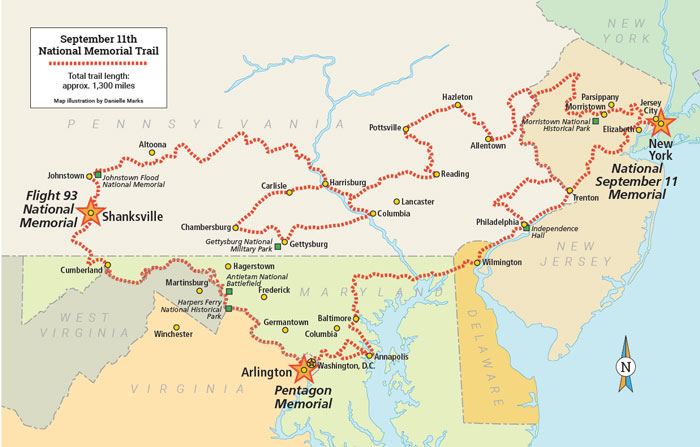
A Grand National Pilgrimage
The project was born four days after 9/11. The visionary behind it, David Brickley, is a former Virginia lawmaker and longtime champion of linear parks. Then director of the Virginia Department of Conservation and Recreation, Brickley had planned a multi-state conference for Sept. 15, 2001, to promote trail connectivity among state, federal and local entities.
Despite the bad timing, 700 trail managers gathered for the conference, only a few miles from the Pentagon. “We decided to show our resilience,” Brickley says. “And while we were there, we hatched this idea of commemorating the fallen and first responders by connecting the three sites into a giant trail.” Thus the September 11th National Memorial Trail Alliance was born.
The concept of linked memorials had never before driven a U.S. trail project. As Brickley and his board quickly discovered, the commemorative goal would unify trail stakeholders at all levels.
“The idea of remembering 9/11 gave tremendous impact to the whole effort,” says Karl King, vice president of Rails to Trails of Central Pennsylvania. While the growing interest in connectivity spurred interest in the project, he explains, “the overriding interest was the desire to commemorate 9/11 and honor the victims and first responders.”
The mission was compelling enough to draw prominent trail leaders to the cause. For example, East Coast Greenway’s Mid-Atlantic Coordinator Andy Hamilton joined the Alliance board and organized charrettes for the trail in communities across New Jersey and Pennsylvania.
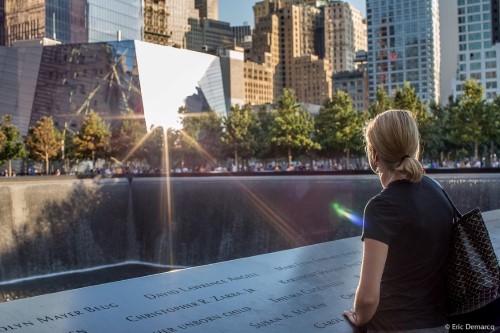
“The response to the 9/11 trail,” Hamilton remarks, “is always of an emotion, not just a trail.”
Lifelong cyclist Eric Brenner, who chairs Maryland’s Bicycle & Pedestrian Advisory Committee, agrees. He describes it as a politically diverse effort characterized by a spirit of cooperation he’s never before experienced.
“For example,” Brenner explains, “the Susquehanna River U.S. Route 40 toll bridge near Havre de Grace [Maryland] has always been a pretty big gap in the East Coast Greenway. But as of July 1, bikes will be allowed [by the Maryland Transportation Administration]. This is a group everyone pays attention to.”
The response to the 9/11 trail is always of an emotion, not just a trail.” – East Coast Greenway Mid-Atlantic Coordinator Andy Hamilton
A New Kind of Heritage Tour
It was trail architect Robert Thomas’ job to plot the NMT’s east-west trail alignment from the GAP to the Delaware Basin. As important as the commemoration of 9/11 is to the project, Thomas observes, the route transcends recent historical events.
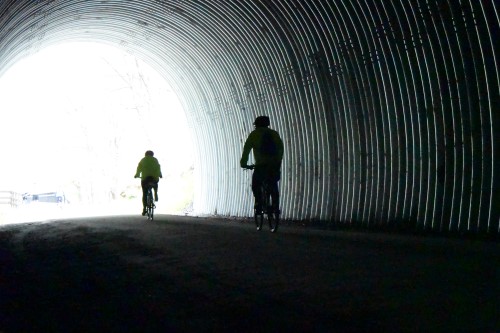
It’s the only leg that is not already determined by large, established trail routes, so Thomas was, in a sense, starting with a blank canvas. Rather than aim for the most direct route, Thomas proposed a path that zigged and zagged through other heritage corridors such as the Johnstown Flood Memorial, Gettysburg National Military Park and Main Line Canal—seeking out community input as he mapped the alignment.
King, who assisted in mapping the east-west route, says the trail highlights pieces of American history unfamiliar to many. The tiny town of Berlin, in Somerset County, Pennsylvania, for example, was the headquarters of the 1794 Whiskey Rebellion. And Main Line Canal lock ruins, visible from the Lower Trail in Blair County, Pennsylvania, testify to 19th-century feats of engineering.
Overall, Thomas stresses, the trail’s alignment does more than link historical sites. “[It] also reflects themes of the trail like tenacity, ingenuity and resilience.”
An Experiment in Connectivity
The September 11th National Memorial Trail is by no means the country’s first super trail. In fact, it would not exist at all if not for the connections already forged by such trails as the GAP and East Coast Greenway. What is unique about the NMT is that its founders sought to piggyback along existing trails rather than merge them.
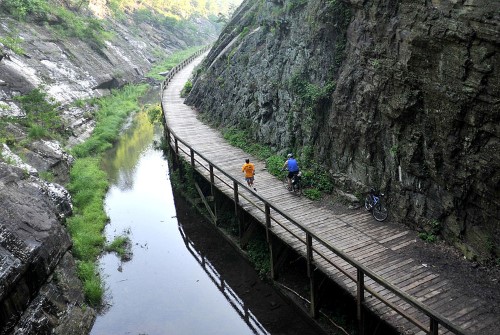
Morris County, New Jersey, offers a striking example of this kind of partnership. County Assistant Trails Superintendent Russ Nee manages Patriots’ Path, a section of the Liberty-Water Gap Trail that includes Revolutionary War sites such as Jockey Hollow.
Nee first heard about the NMT project through a local colleague. “He asked if I’d like to get involved. I said, ‘Are you kidding? Of course!’”
Nee says the trail partnership works because local trails are showcased, not drowned out, by the national memorial theme. “One of the most important things about the trail,” he states, “is that it respects local wishes and work.”
Where connections did not exist, the Alliance requested donations of land and rights-of-way. The most important of those donations, a 130-acre right-of-way connecting the Flight 93 memorial to the GAP, came just this year from the railroad company CSX.
Congressman Bill Shuster (R-Pa.), who represents the district that includes Somerset County, advocated for the NMT in discussions with CSX. “A project of this magnitude,” Shuster observes, “does not get done without government and nongovernment entities working together with the common goal of honoring our heroes.”
Fifteen Years After 9/11
This year marks the 15th anniversary of the 2001 attacks. The vision of a completed triangle of memorials has become a reality, though parts of the trail still await signage and improvements.
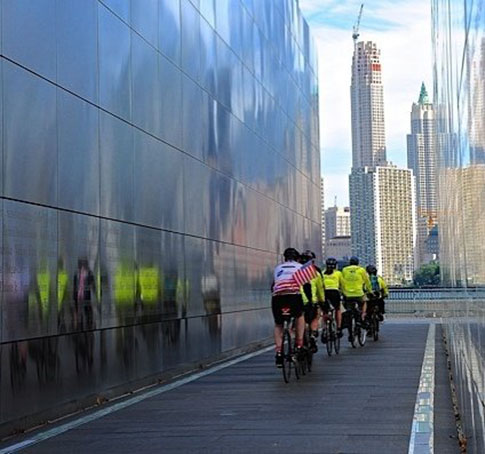
The inaugural trail ride left Garrett (where the GAP connects with the Flight 93 memorial) for New York on Sept. 10 last year. As Alliance board members Brenner and Hamilton pedaled across Pennsylvania and New Jersey, they encountered an outpouring of small-town welcomes—invitations to memorial dedications and potluck dinners, as well as conversations with first responders and others affected by the events of 9/11.
Brenner believes memorial trips like his inaugural ride will become common, beginning with long-distance cyclists and widening to include day-trippers, hikers, motorcycle groups and drivers.
The trail, he says, is a work in progress, and like the Appalachian Trail, it will continue to evolve. He predicts the communities it passes through will see economic and cultural revival as towns along the GAP have.
Trail founder Brickley also believes the trail will bring new life to the communities along its path—and cites plans to seek a federal trails designation and pursue funding for more improvements. Most of all, Brickley (like every other person interviewed for this article) expresses hope that the contagious spirit of unity and cooperation will continue, in a national mission that uses the power of trails to point to shared remembrances and heritage.
SEPTEMBER 11TH NATIONAL MEMORIAL TRAIL MILEAGE
Without Spurs
New York City to Pentagon Memorial, D.C. (East Coast Greenway): 337 miles
Pentagon Memorial to C&O Canal (in Georgetown): 3 miles
C&O Canal Trail (D.C. to Cumberland, Md.): 184 miles
Great Allegheny Passage (Cumberland, Md., to Garrett, Pa.): 36 miles
Great Allegheny Passage to Flight 93 Memorial: 21 miles
Flight 93 Memorial to New Jersey (Delaware Water Gap): 485 miles
Delaware Water Gap (Liberty Water Gap Trail) to New York City: 130 miles
TOTAL: 1,196 miles
With Spurs
Garrett, Pa., to Rockwood, Pa.: 8 miles
Rockwood, Pa., to Pittsburgh, Pa.: 104 miles
Pentagon Memorial, D.C., to Mt. Vernon, Va. (Mt. Vernon Trail): 18 miles
GRAND TOTAL: 1,326 Miles
This article is from the Fall 2016 issue of Rails to Trails magazine, which is hitting mailboxes in late September. It has been republished here in an edited format. Note: The September 11th National Memorial Trail Alliance is holding a ribbon cutting on Sept. 10 to celebrate the opening of a 21-mile segment of trail between the Flight 93 Memorial and Great Allegheny Passage at Garrett, Pennsylvania! Learn more.

Donate
Everyone deserves access to safe ways to walk, bike, and be active outdoors.
